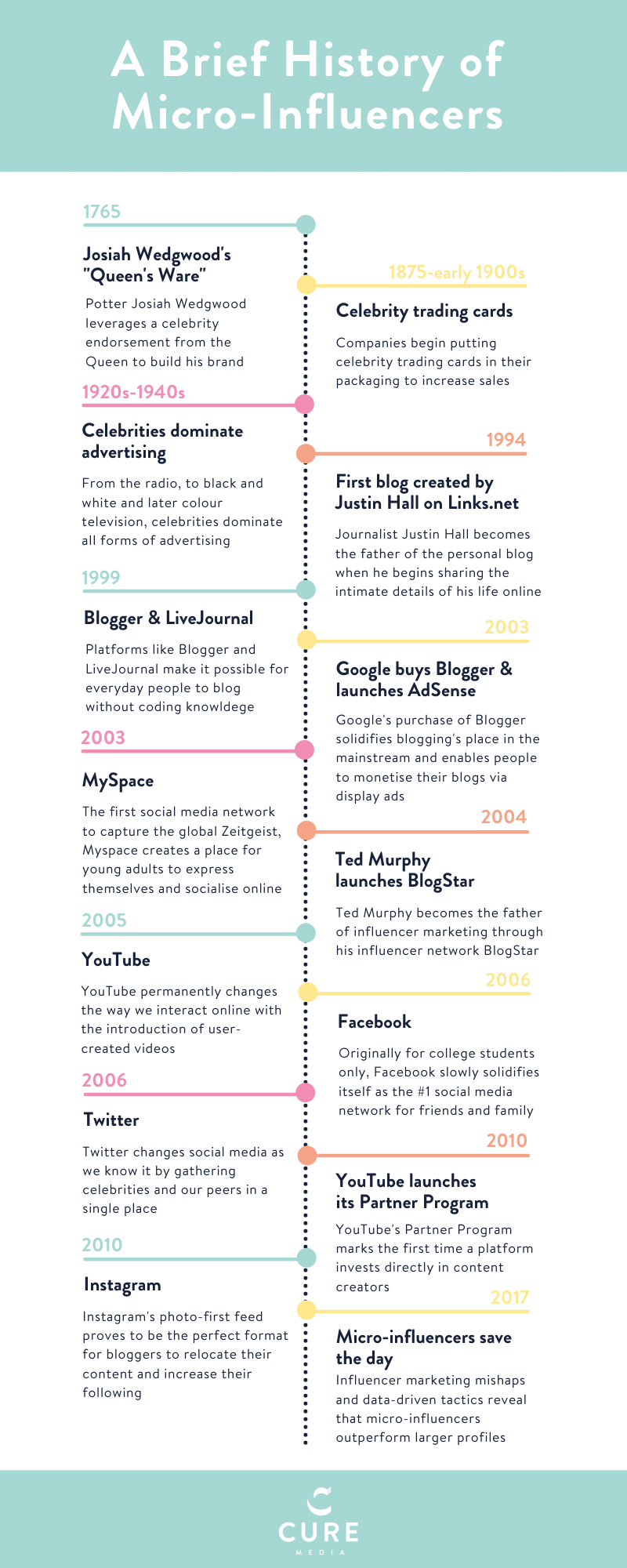Micro-influencers have been the name of the influencer game for a few years now. In 2021, they accounted for 91% of the influencer market and their impact on the industry is only expected to grow.
Today’s brands gravitate towards micro-influencers for a lot of reasons. They help brands enter niche markets, are budget-friendly, and have highly engaged audiences, among other things.
But, it hasn’t always been this way. It was only a year or two ago that celebrities and mega-influencers dominated consumers’ social feeds and brands’ social media budgets.
In this article, we’ll take you back to the origins of influencer marketing and explain how advances in technology, changes in media consumption, and ultimately consumer preferences brought us to where we are today: the age of the micro-influencer.
Influencer marketing through the eras
In the past, we were limited to the advice of our friends and family when we wanted to make an informed decision. And if we were lucky, a trustworthy friend-of-a-friend who happened to have expertise in that area.
Today, we still rely on friends and family, as well as subject experts and people we trust, when making important decisions. The only thing that has changed over time is the number of people and the amount of information we have access to.
So, although the word influencer as we know it has only been around for a little over a decade, the concept of an influencer – a tastemaker with influence over the purchasing decisions of others – has been around ad infinitum.
Royals were among the first influencers. If you do a quick Google search, you’ll likely find anecdotes about Josiah Wedgwood, an English potter from the late 1700s who used Queen Charlotte’s celebrity to bolster the market appeal of his pottery lines. By branding his pottery as “the Queen’s ware”, Wedgwood was able to sell his products at twice their original price across the U.K. He is now known as the father of influencer marketing.
As technology advanced, so did influencer marketing. By the late 1800s, brands began to place trading cards featuring celebrities inside of their packaging. Customers, in turn, flocked to these products in hopes of collecting each trading card. Celebrity endorsements continued throughout the 1900s and constantly evolved alongside consumer technology, from radios to black and white (and later, coloured) television, all the way to the internet.

Every blog has its day
Despite the advancements in media consumption, one thing stayed constant: advertisements were a one-way conversation from media companies and their celebrity endorsers to consumers. All of this changed when the internet became mainstream in the early 90s.
New websites were popping up every day, and many of them were forums where people could get advice from experts on every topic imaginable. It’s hard for us to imagine today, but these forums were the first time people could easily access consumer information that didn’t come from their peers or traditional advertisements.
The shift in power from companies to consumers proved to be popular, and eventually, the tastemakers and experts from the early days of internet forums created their own websites to share their thoughts and ideas. The word “blog” was coined to describe these personal pages.
Blogs’ popularity skyrocketed throughout the late 90s and into the early 2000s once platforms like LiveJournal and Blogger made blogging accessible to everyone – no coding knowledge required. This is also where we can pinpoint the most recent descendants of social media influencers.
Through their personal style, industry insights, and candidness, a handful of bloggers began to make a name for themselves. Their openness and relatability amassed large, dedicated readerships that eagerly waited for each new blog post. And just like that, bloggers became mini-celebrities overnight.
If you build an audience, marketers will come
At the same time that bloggers were gaining celebrity, pop-up and banner ads were gaining enemies. Just like today, people found these digital ads to be distracting and inauthentic.
The timing couldn’t be more perfect. Marketers were looking for a better way to reach consumers online, and bloggers presented their authenticity and sizable audiences to them on a silver platter.
Sponsored blog posts were the natural outcome. Bloggers, especially those within fashion and beauty, had already been promoting their favourite brands and products on their pages.
Now, by working with brands directly, they could turn their hobby into a profitable career.
At this point, the most popular bloggers were full-fledged influencers. This caught the attention of entrepreneurs like Ted Murphy who created “The BlogStar Network” –
the first influencer marketing platform. Platforms like BlogStar democratised sponsored blog posts by connecting brands to an email list of bloggers interested in endorsing their products.

Social media has entered the chat
Just as they did with bloggers, marketers scrambled to find the social media profiles with the biggest audiences to promote their products throughout the early 2010s. It was around this time that the word influencer entered the lexicon.a
Still new to the channel, it makes sense that brands turned to the time-tested metric of audience size in the early days of influencer marketing. The more followers an influencer has, the more people engage with your product, right? Wrong.
It wasn’t long until marketers realised that a profile’s number of followers does not correlate to higher levels of trust and engagement among audiences. A celebrity may have millions of fans, but that doesn’t mean they’re a trusted source of consumer information, especially when it comes to complex things like nutrition or finances.
Marketers learned another hard lesson about working with big influencers: their followers might not even be real. Instead, the bigger an influencer is, the more likely that a significant percentage of their followers are robots, fake and spam accounts, inactive users, and journalists. In other words, followers that have no interest in their product recommendations.
Micro-influencers to the rescue
After only a few years, influencer marketing was coming to a crossroads. The market was saturated, both in terms of ad spend and the sheer volume of influencers.
The original USP of influencer marketing – authenticity and personability – was difficult to find. In some cases, mega-influencers originally hailed for their expertise now had social feeds packed with conflicting product endorsements. In others, celebrities were promoting products they clearly had no knowledge of.
While PR teams headed up damage control for influencer campaigns gone wrong, digital marketers turned their focus to measuring and analysing these campaigns in hopes of improving them in the future.
These marketing gurus ultimately found that smaller influencers were actually performing better than mega and celebrity profiles. But, should that really have surprised us?
As we said in the beginning, consumers have always wanted to make informed decisions and instinctively turn to those they trust for advice. We may aspire to be like celebrities, but it’s unlikely that we trust or relate to them.
So, the success of micro-influencers confirms what we knew all along: the more relatable, honest, and genuine an influencer is, the more people that will seek out their recommendations.
But, what are the benefits of micro-influencers, and what makes them so powerful? We see two characteristics in particular that give micro-influencers their je ne sais quoi.
Micro-influencers, like the bloggers and vloggers before them, feel like friends to their followers. They interact with them directly, only promote products they would use themselves, and share the ups and downs of their everyday lives.
Another special thing about micro-influencers is their originality. They tend to be less interested in trends, and more interested in sharing their personal aesthetic and lifestyle. Micro-influencers take pride in occupying a niche much more than maintaining mass appeal. As a micro-influencer agency, we love working with original and authentic creators!
The story isn’t over yet
After tracing micro-influencers to their roots, we hope it’s clear that their story is far from over. Technology is constantly changing and people are happy to change alongside it. What doesn’t change, however, is our desire to make informed decisions and seek out advice from the people we trust. In today’s social media landscape, those people are micro-influencers, but who knows what tomorrow holds.



